SNOSB30P October 2008 – January 2015 LMH6554
PRODUCTION DATA.
- 1 Features
- 2 Applications
- 3 Description
- 4 Typical Application Schematic
- 5 Revision History
- 6 Pin Configuration and Functions
- 7 Specifications
- 8 Detailed Description
- 9 Application and Implementation
- 10Power Supply Recommendations
- 11Layout
- 12Device and Documentation Support
- 13Mechanical, Packaging, and Orderable Information
7 Specifications
7.1 Absolute Maximum Ratings (1)(2)(4)
| MIN | MAX | UNIT | ||
|---|---|---|---|---|
| Supply Voltage (VS = V+ - V−) | 5.5 | V | ||
| Common Mode Input Voltage | V- | V+ | V | |
| Maximum Operating Junction Temperature | 150 | °C | ||
| Maximum Input Current | 30 | mA | ||
| Maximum Output Current (pins 12, 13) | (3) | mA | ||
| Soldering Information | 260 | °C | ||
| Infrared or Convection (30 sec) | ||||
| Storage Temperature, Tstg | −65 | 150 | °C | |
(1) Absolute Maximum Ratings indicate limits beyond which damage to the device may occur. Recommended Operating Conditions indicate conditions for which the device is intended to be functional, but specific performance is not ensured. For ensured specifications, see the Electrical Characteristics: +5 V tables.
(2) If Military/Aerospace specified devices are required, please contact the Texas Instruments Sales Office/ Distributors for availability and specifications.
(3) The maximum output current (IOUT) is determined by device power dissipation limitations. See Power Dissipation for more details.
(4) For soldering specifications, see SNOA549.
7.2 ESD Ratings
| VALUE | UNIT | |||
|---|---|---|---|---|
| V(ESD) | Electrostatic discharge | Human-body model (HBM), per ANSI/ESDA/JEDEC JS-001(1) | ±2000 | V |
| Charged-device model (CDM), per JEDEC specification JESD22-C101(2) | ±750 | |||
| Machine model (MM) | ±250 | |||
(1) JEDEC document JEP155 states that 500-V HBM allows safe manufacturing with a standard ESD control process.
(2) JEDEC document JEP157 states that 250-V CDM allows safe manufacturing with a standard ESD control process.
7.3 Recommended Operating Conditions
See (1)| MIN | NOM | MAX | UNIT | |
|---|---|---|---|---|
| Operating Temperature Range | −40 | +125 | °C | |
| Total Supply Voltage Temperature Range | 4.7 | 5.25 | V |
7.4 Thermal Information
| THERMAL METRIC(1) | LMH6554 | UNIT | |
|---|---|---|---|
| NHJ | |||
| 14 PINS | |||
| RθJA | Junction-to-ambient thermal resistance | 60 | °C/W |
(1) For more information about traditional and new thermal metrics, see the IC Package Thermal Metrics application report, SPRA953.
7.5 Electrical Characteristics: +5 V
Unless otherwise specified, all limits are ensured for TA = +25°C, AV = +2, V+ = +2.5 V, V− = −2.5 V, RL = 200 Ω, VCM = (V++V-)/2, RF = 200 Ω, for single-ended in, differential out.(1)| PARAMETER | TEST CONDITIONS | MIN (4) | TYP (3) | MAX (4) | UNIT | ||
|---|---|---|---|---|---|---|---|
| AC PERFORMANCE (DIFFERENTIAL) | |||||||
| SSBW | Small Signal −3 dB Bandwidth (4) | AV = 1, VOUT = 0.2 VPP | 2800 | MHz | |||
| AV = 2, VOUT = 0.2 VPP | 2500 | ||||||
| AV = 4, VOUT = 0.2 VPP | 1600 | ||||||
| LSBW | Large Signal Bandwidth | AV = 1, VOUT = 2 VPP | 1800 | MHz | |||
| AV = 2, VOUT = 2 VPP | 1500 | ||||||
| AV = 2, VOUT = 1.5 VPP | 1900 | ||||||
| 0.1 dBBW | 0.1 dB Bandwidth | AV = 2, VOUT = 0.2 VPP, RF = 250Ω | 830 | MHz | |||
| SR | Slew Rate | 4V Step | 6200 | V/μs | |||
| tr/tf | Rise/Fall Time | 2V Step, 10–90% | 290 | ps | |||
| 0.4V Step, 10–90% | 150 | ||||||
| Ts_0.1 | 0.1% Settling Time | 2V Step, RL = 200Ω | 4 | ns | |||
| Overdrive Recovery Time | VIN = 2V, AV = 5 V/V | 6 | ns | ||||
| DISTORTION AND NOISE RESPONSE | |||||||
| HD2 | 2nd Harmonic Distortion | VOUT = 2 VPP, f = 20 MHz | -102 | dBc | |||
| VOUT = 2 VPP, f = 75 MHz | -96 | ||||||
| VOUT = 2 VPP, f = 125 MHz | -87 | ||||||
| VOUT = 2 VPP, f = 250 MHz | −79 | ||||||
| VOUT = 1.5 VPP, f = 250 MHz | −81 | ||||||
| HD3 | 3rd Harmonic Distortion | VOUT = 2 VPP, f = 20 MHz | −110 | dBc | |||
| VOUT = 2 VPP, f = 75 MHz | −97 | ||||||
| VOUT = 2 VPP, f = 125 MHz | −87 | ||||||
| VOUT = 2 VPP, f = 250 MHz | −70 | ||||||
| VOUT = 1.5 VPP, f = 250 MHz | −75 | ||||||
| OIP3 | Output 3rd-Order Intercept | f = 150 MHz, VOUT = 2VPP Composite | 46.5 | dBm | |||
| IMD3 | Two-Tone Intermodulation | f = 150 MHz, VOUT = 2VPP Composite | −97 | dBc | |||
| en | Input Voltage Noise Density | f = 10 MHz | 0.9 | nV/√Hz | |||
| in+ | Input Noise Current | f = 10 MHz | 11 | pA/√Hz | |||
| in- | Input Noise Current | f = 10 MHz | 11 | pA/√Hz | |||
| NF | Noise Figure (8) | 50Ω System, AV = 7.3, 100 MHz | 7.7 | dB | |||
| INPUT CHARACTERISTICS | |||||||
| IBI+ / IBI- | −75 | −29 | 20 | µA | |||
| TCIbi | Input Bias Current Temperature Drift | 8 | µA/°C | ||||
| IBID | Input Bias Current (6) | VCM = 0V, VID = 0V, IBOFFSET = (IB- - IB+)/2 |
−10 | 1 | 10 | μA | |
| TCIbo | Input Bias Current Diff Offset Temperature Drift (3) | 0.006 | µA/°C | ||||
| CMRR | Common Mode Rejection Ratio | DC, VCM = 0V, VID = 0V | 83 | dB | |||
| RIN | Differential Input Resistance | Differential | 19 | Ω | |||
| CIN | Differential Input Capacitance | Differential | 1 | pF | |||
| CMVR | Input Common Mode Voltage Range | CMRR > 32 dB | ±1.25 | ±1.3 | V | ||
| OUTPUT PERFORMANCE | |||||||
| Output Voltage Swing (3) | Single-Ended Output | ±1.35 | ±1.42 | V | |||
| IOUT | Output Current (3) | VOUT = 0V | ±120 | ±150 | mA | ||
| ISC | Short Circuit Current | One Output Shorted to Ground VIN = 2V Single-Ended (2) |
150 | mA | |||
| Output Balance Error | ΔVOUT Common Mode /ΔVOUT Differential, ΔVOD = 1V, f < 1 Mhz | −64 | dB | ||||
| OUTPUT COMMON MODE CONTROL CIRCUIT | |||||||
| Common Mode Small Signal Bandwidth | VIN+ = VIN− = 0V | 500 | MHz | ||||
| Slew Rate | VIN+ = VIN− = 0V | 200 | V/μs | ||||
| VOSCM | Input Offset Voltage | Common Mode, VID = 0, VCM = 0V | −16 | −6.5 | 4 | mV | |
| IOSCM | Input Offset Current | (5) | 6 | 18 | μA | ||
| Voltage Range | ±1.18 | ±1.25 | V | ||||
| CMRR | Measure VOD, VID = 0V | 82 | dB | ||||
| Input Resistance | 180 | kΩ | |||||
| Gain | ΔVOCM/ΔVCM | 0.99 | 0.995 | 1.0 | V/V | ||
| MISCELLANEOUS PERFORMANCE | |||||||
| ZT | Open Loop Transimpedance Gain | Differential | 180 | kΩ | |||
| PSRR | Power Supply Rejection Ratio | DC, ΔV+ = ΔV− = 1V | 74 | 95 | dB | ||
| IS | Supply Current (3) | RL = ∞ | 46 | 52 | 57 | mA | |
| At extreme temperatures | 60 | ||||||
| Enable Voltage Threshold | Single 5V Supply (7) | 2.5 | V | ||||
| Disable Voltage Threshold | Single 5V Supply (7) | 2.5 | V | ||||
| Enable/Disable Time | 15 | ns | |||||
| ISD | Supply Current, Disabled | Enable=0, Single 5-V supply | 450 | 510 | 570 | μA | |
| At extreme temperatures | 600 | ||||||
(1) Electrical Table values apply only for factory testing conditions at the temperature indicated. Factory testing conditions result in very limited self-heating of the device such that TJ = TA. No specification of parametric performance is indicated in the electrical tables under conditions of internal self-heating where TJ > TA. See Thermal Information for information on temperature de-rating of this device." Min/Max ratings are based on product characterization and simulation. Individual parameters are tested as noted.
(2) Short circuit current should be limited in duration to no more than 10 seconds. See Power Dissipation for more details.
(3) Typical values represent the most likely parametric norm as determined at the time of characterization. Actual typical values may vary over time and will also depend on the application and configuration. The typical values are not tested and are not ensured on shipped production material.
(4) Limits are 100% production tested at 25°C. Limits over the operating temperature range are ensured through correlation using Statistical Quality Control (SQC) methods.
(5) Negative input current implies current flowing out of the device.
(6) IBI is referred to a differential output offset voltage by the following relationship: VOD(OFFSET) = IBI*2RF.
(7) VEN threshold is typically +/-0.3V centered around (V+ + V-) / 2 relative to ground.
(8) For test schematic, refer to Figure 34.
7.6 Typical Performance Characteristics VS = ±2.5 V
(TA = 25°C, RF = 200 Ω, RG = 90 Ω, RT = 76.8 Ω, RL = 200 Ω, AV = +2, for single ended in, differential out, unless specified).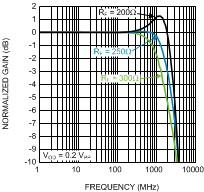 Figure 1. Frequency Response vs RF
Figure 1. Frequency Response vs RF
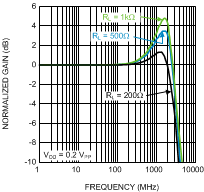 Figure 3. Frequency Response vs RL
Figure 3. Frequency Response vs RL
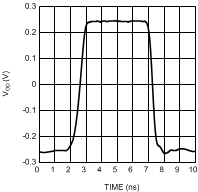 Figure 5. 0.5 VPP Pulse Response Single-Ended Input
Figure 5. 0.5 VPP Pulse Response Single-Ended Input
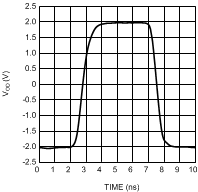 Figure 7. 4 VPP Pulse Response Single-Ended Input
Figure 7. 4 VPP Pulse Response Single-Ended Input
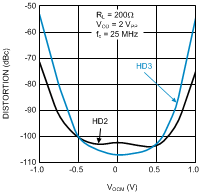 Figure 9. Distortion vs Output Common Mode Voltage
Figure 9. Distortion vs Output Common Mode Voltage
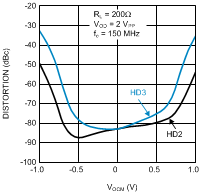 Figure 11. Distortion vs Output Common Mode Voltage
Figure 11. Distortion vs Output Common Mode Voltage
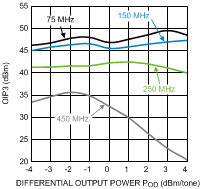 Figure 13. OIP3 vs Output Power POUT
Figure 13. OIP3 vs Output Power POUT
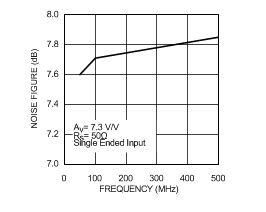 Figure 15. Noise Figure vs Frequency
Figure 15. Noise Figure vs Frequency
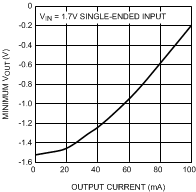 Figure 17. Minimum VOUT vs IOUT
Figure 17. Minimum VOUT vs IOUT
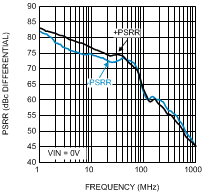 Figure 19. PSRR
Figure 19. PSRR
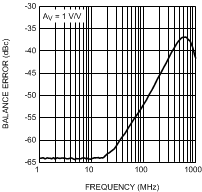 Figure 21. Balance Error
Figure 21. Balance Error
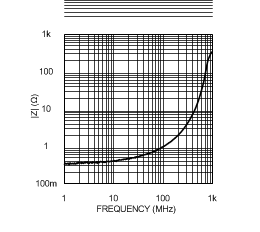 Figure 23. Closed-Loop Output Impedance
Figure 23. Closed-Loop Output Impedance
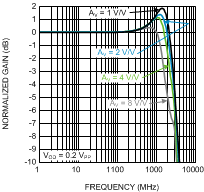 Figure 2. Frequency Response vs Gain
Figure 2. Frequency Response vs Gain
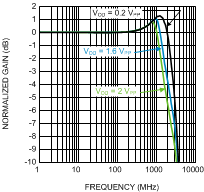 Figure 4. Frequency Response vs Output Voltage (VOD)
Figure 4. Frequency Response vs Output Voltage (VOD)
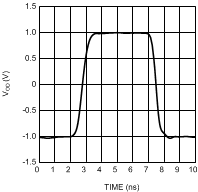 Figure 6. 2 VPP Pulse Response Single-Ended Input
Figure 6. 2 VPP Pulse Response Single-Ended Input
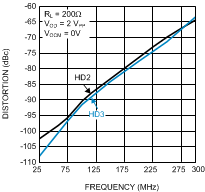 Figure 8. Distortion vs Frequency Single-Ended Input
Figure 8. Distortion vs Frequency Single-Ended Input
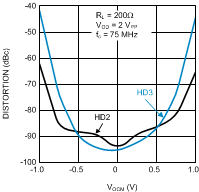 Figure 10. Distortion vs Output Common Mode Voltage
Figure 10. Distortion vs Output Common Mode Voltage
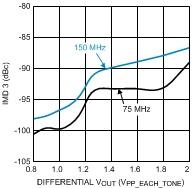 Figure 12. 3rd Order Intermodulation Products vs VOUT
Figure 12. 3rd Order Intermodulation Products vs VOUT
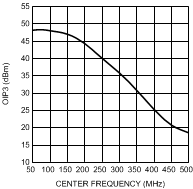 Figure 14. OIP3 vs Center Frequency
Figure 14. OIP3 vs Center Frequency
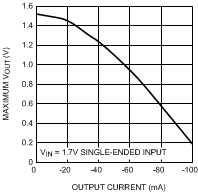 Figure 16. Maximum VOUT vs IOUT
Figure 16. Maximum VOUT vs IOUT
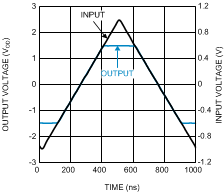 Figure 18. Overdrive Recovery
Figure 18. Overdrive Recovery
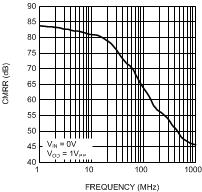 Figure 20. CMRR
Figure 20. CMRR
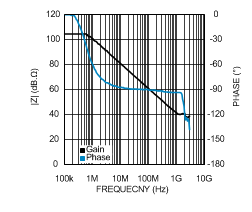 Figure 22. Open Loop Transimpedance
Figure 22. Open Loop Transimpedance
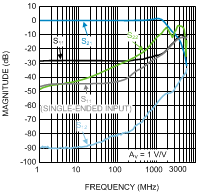 Figure 24. Differential S-Parameter Magnitude vs Frequency
Figure 24. Differential S-Parameter Magnitude vs Frequency